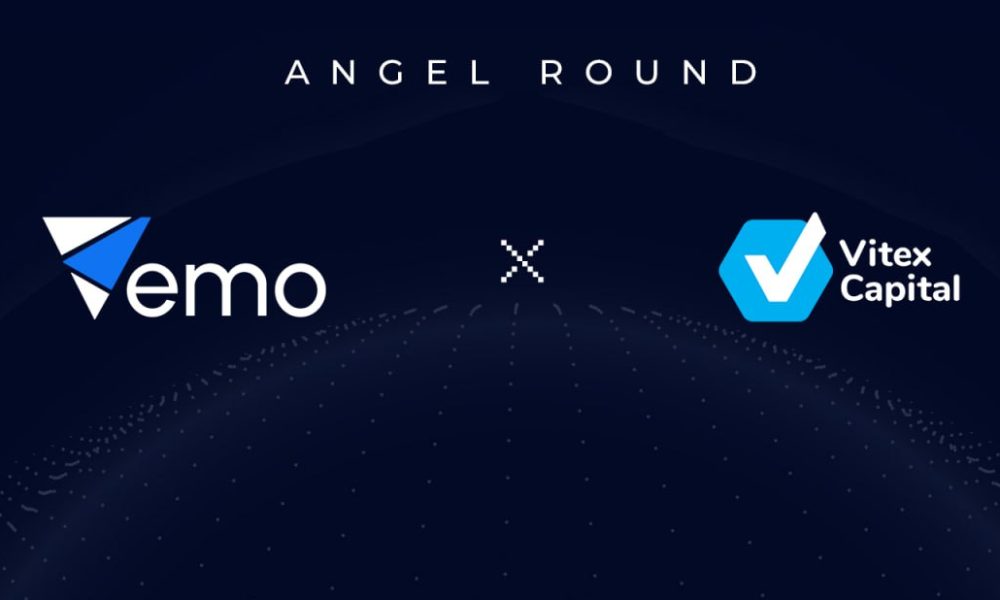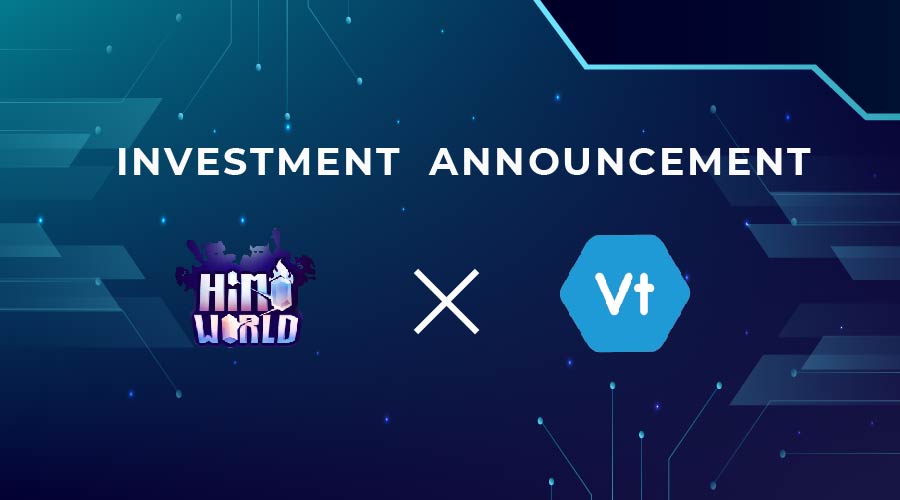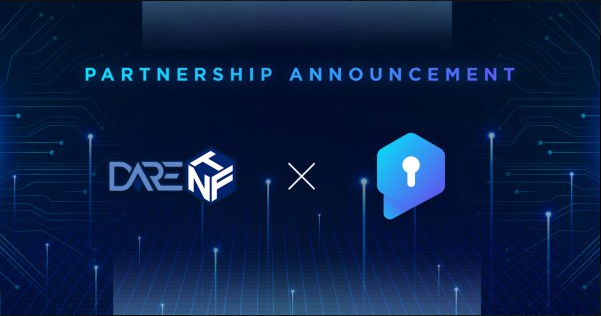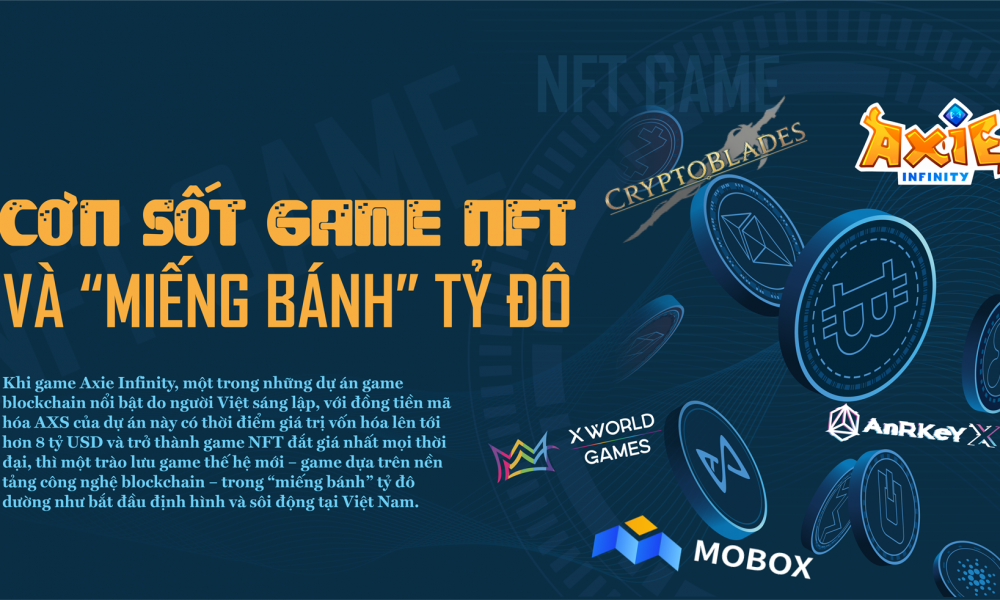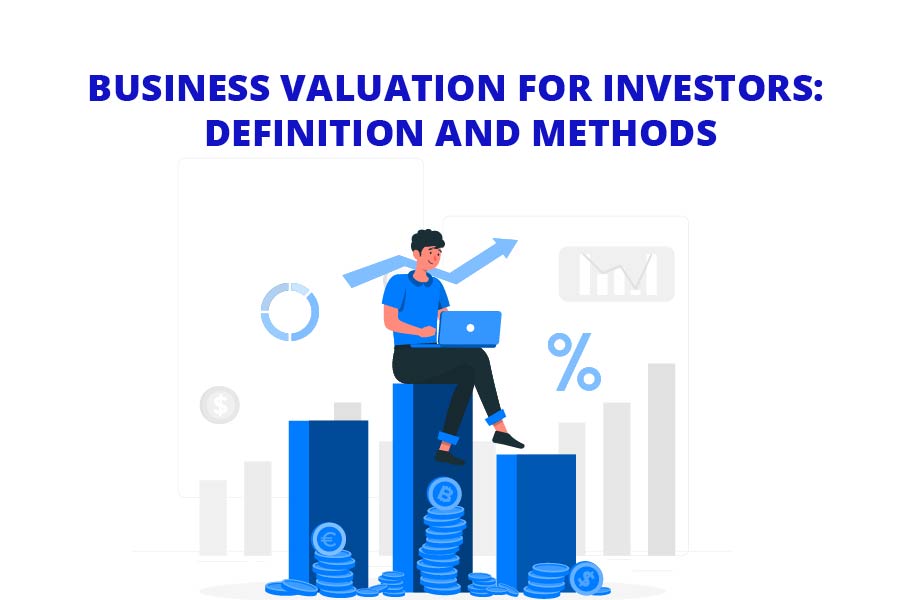Tin tức 2
Follow our blog and stay up to date.
‼️VEMO NETWORK SECURES INVESTMENT FROM VITEX CAPITAL! 🚀
We’re beyond happy to announce that Vitex Capital has strategically invested in Vemo Network during its angel round! This tactful investment further emphasizes our significant commitment in supporting pioneering innovations in futuristic blockchain technology.
Vemo Network is set to transform how locked positions are traded, unlocking new liquidity opportunities across the decentralized finance space. Vemo is expected to offer a way to bridge the critical gap in the DeFi ecosystem. With our backing, they will accelerate the development of cutting-edge technology, enhance their UI/UX experience, and expand their applications—especially as they continue building on Berachain and beyond.
At Vitex Capital, we invest in visionary teams and breakthrough technologies that push the boundaries of Web3. Our investment in Vemo Network is a testament to the confidence we have in their team, their long-term vision, and their ability to redefine on-chain liquidity solutions.
This investment is a testament to the strong confidence in our vision, technology, and long-term potential. We’re just getting started, and the best is yet to come!
#Vemo Network Official Links:
Website | Twitter | Discussion
What is a Gaming Guild?
Gaming guilds are communities of gamers that aim to create economies in the virtual world by sponsoring millions of players, investing in games to monetize their in-game content, and building tools to enhance future game development.
Gaming Guilds provide players with the money and tools needed to experience the ever-increasing amount of Play to Earn (P2E) games at the expense of a portion of their earnings.
Here’s an example: Because buying an Axie on the popular blockchain game Axie Infinity can be quite expensive, some guild users are willing to give up some of their earnings to rent in-game assets from the guild.
If 2021 proves to be a year for crypto games and their tokens, will 2022 turn out to be the year for Gaming Guilds that support compelling gaming conditions like Axie Infinity or The Sandbox?
It’s too early to tell but crypto investors who have profited from the bull market are accumulating money for this boom.
Why Gaming Guilds Will Explode
Unlike traditional gaming guilds, which are organized groups of gamers who regularly play together in a game, Crypto Gaming Guilds are game-independent. Instead, they aim to be a platform that supports new gamers.
It also explains why investors are betting big on Gaming Guilds: There are hundreds of NFT games hoping to be the next Axie Infinity.
Data from DappRadar shows about 106,000 daily active users on Axie Infinity or various wallet addresses interacting with the game, as of press time, down from the November peak of around 135,800.
Darryl Wang, the senior investment analyst at crypto investment firm DeFinance Capital, wrote on Twitter: “If the game is a high risk/high return, the associations will be the initiators. The blue-chip industry has stood the test of time.
“The Gaming Guilds will become the best opportunity for players to play the best game.”
According to Akaradet Diawpanich, co-founder of GuildFi, NFT gaming guilds have the potential to create a “positive feedback loop” in which they bring players into the game, buying non-fungible tokens (NFT) in-game and lend it to players, invest in different games and help them target potential users.
In an interview with CoinDesk, Diawpanich said GuildFi started expanding after seeing a surge in demand for rental properties during the booming time amid the COVID-19 pandemic. GuildFi is also currently providing gadgets for gamers in various games. For example, Axie players can track their daily SLP rewards on GuildFi easily.
Ultimately, GuildFi, according to Diawpanich, is trying to become Steam, a video game distribution service, for crypto games.
Why do Gaming Guilds need tokens?
It’s no surprise that YGG, GuildFi, and Merit Circle — some of the more successful crypto organizations this year — all have their own tokens. But even the most prized of them, YGG, which has a market cap of $461 million, according to CoinGecko, is still far from the value of crypto gaming darlings such as AXS (6.6 billion dollars) or MANA ($4.4 billion).
In an analysis of crypto gaming guilds, Wayne Zhao, a partner at Beijing-based blockchain data firm TokenInsight, wrote that some traditional gaming guilds have ended badly. after guild members discovered community leaders were being paid by game companies to promote games.
With the token’s launch, however, crypto associations have the potential to tackle the “over-centralization” problem of traditional gaming associations, according to analysts.
“Traditional gaming associations act as social facilitators, but nothing more,” Wang of DeFiance Capital told CoinDesk. “Gaming Guilds take on a much more important economic role due to the nature of on-chain digital assets that players use and care about.”
Zhao said in an interview with CoinDesk, a decentralized autonomous organization (DAO) can bring together a random group of people with different motivations to build and grow together because of incentives to share.
“At its core, tokens are one of the incentives for members to participate in group decision-making,” Zhao said of clan governance. Each individual can benefit from the total profit earned
Summary
Gaming Guilds is slowly budding and is expected to become a trend in the future. As the epidemic continues, the economy is still struggling and the Play to earn model is becoming more and more popular in the daily lives of people around the world. Gaming Guilds will be the key to opening the limited door to make GameFi even more explosive
6 key differences between Metaverse and virtual reality
In October 2021, Mark Zuckerberg announced that Facebook would change its name to Meta.
Meta is an adjective that means an object is referring to itself. But at the same time, it also stands for something called the metaverse.
This announcement was met with curiosity, skepticism, and the obvious question: “What exactly is the metaverse?” It sounds like the metaverse is pretty much like virtual reality.
So how is the metaverse different from virtual reality, and do you need a Facebook-made VR headset to access it?
What is the difference between Metaverse and virtual reality (VR)?
If you’ve read through the articles about the metaverse, the similarities between it and virtual reality are hard to deny. However, there are some important differences.
Here are 6 key differences between virtual reality and metaverse.
1. Virtual reality is well defined, Metaverse is not
The most notable difference between virtual reality and the metaverse is that while VR is now well understood, the actual metaverse is still very vague.
According to Mark Zuckerberg, the metaverse is “an embodiment of the Internet, where instead of just viewing the content, you can stay in it”. A recent announcement from Microsoft described the metaverse as “a digital world where digital twins of people, places, and things exist”.
These descriptions are rather vague when compared to our understanding of virtual reality. It is also possible that even the technology companies themselves do not have a complete definition of the concept.
According to Facebook, the decision to rebrand is a necessary part of building the metaverse. The company wanted a name that better represented what the company was doing. But it’s certainly not the only good reason to do so. The image of Facebook is also not very good in the eyes of users.
It has also been suggested that the metaverse is nothing more than a buzzword to describe technological innovations in the existing Internet.
2. Facebook does not own either of these technologies
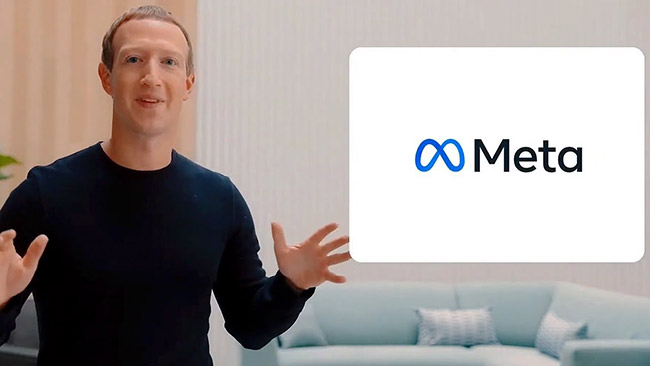
Another potential question about the metaverse is who can actually define it.
As the owner of the Oculus Rift, Facebook played an important role in the development of virtual reality. But at the same time, the firm is just one player in a huge industry.
The same is true of the metaverse. Facebook may have changed its name to Meta, but it’s not the only company entering the field. For example, Microsoft recently announced Microsoft Mesh, a version of its mixed reality platform with similarities to the metaverse and many different definitions. Furthermore, a recent statement from Facebook alludes to the fact that the company considers itself part of the metaverse. This means that, like VR, the metaverse will not be confined to a single company.
3. Metaverse includes a shared virtual world
Metaverse is a shared virtual space that users can access through the Internet. Again, this is what VR headsets have clearly allowed you to do. The virtual space in the metaverse sounds similar to the space that already exists in virtual reality shows.
Users are expected to be identified by personal avatars and interact with each other in virtual locations. In addition, they will be able to purchase or build virtual items and environments, such as NFTs.
The fundamental difference is that although virtual worlds are currently limited in size, the metaverse sounds like it will provide access to the entire Internet.
4. Metaverse will be accessible in virtual reality
Metaverse will not require you to wear a VR headset. But it is believed that much of this service will be accessible to headset users.
This means that the line between surfing the Internet and using virtual reality can be blurred. VR headsets can begin to be used for tasks normally performed with smartphones. If the metaverse becomes as widespread as Facebook hopes, VR is more or less likely to become a niche product.
5. Metaverse won’t be limited to VR

However, the metaverse will not be limited to virtual reality. Instead, it will be accessible by both an augmented reality device and whatever device you already use to connect to the Internet.
This opens the door to many different features that are not possible with virtual reality. For example, augmented reality will allow aspects of the metaverse to be projected into the real world.
Virtual spaces will also be designed so that they can be accessed anywhere without the need for a headset.
6. Metaverse has much greater potential than VR
Virtual reality is currently used for education, therapy and sports. But it is still said to be best suited as a form of entertainment.
The Metaverse, at least in scale, sounds like a new and improved version of the Internet. It is expected to change the way people work, access social media and even surf the web, meaning that while many people have completely abandoned virtual reality, the same is unlikely to happen with the metaverse. .
Will Metaverse replace the Internet?
Virtual reality hasn’t had quite the impact on the world as some expected. There is a limit to how long people want to wear headphones.
Metaverse won’t have this problem, accessible to both those with and without access to a VR headset. Some expect it to have a much larger impact.
At the same time, it is very difficult for the metaverse to completely replace the Internet. VR headsets offer an interesting alternative to computer monitors. Metaverse will provide an interesting alternative to the Internet. But neither is designed to act as a replacement for something else.
Announcement of Vitex Capital’s partnership with Himo World
Vitex Capital is pleased to announce our partnership with Himo World project. Vitex Capital will accompany Himo World to develop marketing strategies, provide information for investors, organize events and provide long-term support.
Himo World is an NFT game with a Play-to-Earn feature, in which players can engage in battles with others, build their team to their favourite to explore the universe, or choose to become observers of the war. This game is also providing a true Free-to-Play experience, which a lot of other NFT games in the market is lacking at the moment. Setting up in a distant realm, the player just awoke his summoning power, and realize they now are in the middle of the war between realms, where they fight against each other in a battle of strengths and wits.

Himo World takes you to an epic battle, where you can challenge even Gods. The game has a lot of modes, from Campaign, PvP, to Tournament, Betting,… with monthly updates and worthy rewards.
Setting up in a distant realm, the player just awoke his summonning power, and realize they now are in the middle of the war between realms, where they fight against each other in a battle of strengths and wits.
Vitex Capital focuses investment resources on Blockchain projects, NFT, etc. with great potential and long-term vision. Vitex Capital highly appreciates Himo World because the project has a completed product, a clear development roadmap and is developed by a team of experienced experts who have successfully developed many technology projects.
In addition to financial investment and strategic consulting, Vitex Capital also offers opportunities for Himo World to approach and cooperate with potential investors. Moreover, with expertise and experience in the market, Vitex Capital will help the project reach its full potential and create the NFT gaming revolution.
#HimoWorld Official Links:
Website | Twitter | Discussion | Announce | Medium
6 điểm khác biệt chính giữa Metaverse và thực tế ảo
Vào tháng 10 năm 2021, Mark Zuckerberg thông báo rằng Facebook sẽ đổi tên thành Meta.
Meta là một tính từ có nghĩa là một đối tượng đang đề cập đến chính nó. Nhưng đồng thời, nó cũng là viết tắt của một thứ gọi là metaverse.
Thông báo này đã vấp phải sự tò mò, hoài nghi và câu hỏi hiển nhiên được đặt ra: “Chính xác thì metaverse là gì?” Nghe có vẻ metaverse khá giống như thực tế ảo.
Vậy metaverse khác gì so với thực tế ảo và bạn có cần thiết bị VR do Facebook sản xuất để truy cập nó không?
Sự khác biệt giữa Metaverse và thực tế ảo (VR) là gì?
Nếu bạn đã đọc qua những bài viết về metaverse, thì những điểm tương đồng giữa nó với thực tế ảo rất khó phủ nhận. Tuy nhiên, có một số khác biệt quan trọng.
Sau đây là 6 điểm khác biệt chính giữa thực tế ảo và metaverse.
1. Thực tế ảo được xác định rõ, Metaverse thì không
Sự khác biệt đáng chú ý nhất giữa thực tế ảo và metaverse là trong khi VR hiện đã được hiểu rõ, thì metaverse thực sự vẫn còn rất mơ hồ.
Theo Mark Zuckerberg, metaverse là “một Internet hiện thân, nơi thay vì chỉ xem nội dung, bạn có thể ở luôn trong đó”. Một thông báo gần đây của Microsoft đã mô tả metaverse là “một thế giới kỹ thuật số nơi các cặp song sinh kỹ thuật số của con người, địa điểm và vạn vật tồn tại”.
Những mô tả này khá mơ hồ khi so sánh với hiểu biết của chúng ta về thực tế ảo. Cũng có thể là ngay cả bản thân các công ty công nghệ cũng không có một định nghĩa đầy đủ về khái niệm này.
Theo Facebook, quyết định đổi thương hiệu là một phần cần thiết trong việc xây dựng metaverse. Hãng này muốn một cái tên thể hiện tốt hơn những gì công ty này đang làm. Nhưng nó chắc chắn không phải là lý do chính đáng duy nhất để làm như vậy. Hình ảnh của Facebook cũng không mấy tốt đẹp gì trong mắt người dùng.
Cũng có ý kiến cho rằng metaverse không hơn gì một từ thông dụng để mô tả những cải tiến công nghệ trong mạng Internet hiện có.
2. Facebook không sở hữu một trong hai công nghệ này

Một câu hỏi tiềm năng khác về metaverse là ai thực sự có thể xác định nó.
Là chủ sở hữu của Oculus Rift, Facebook đóng một vai trò quan trọng trong sự phát triển của thực tế ảo. Nhưng đồng thời, hãng này cũng chỉ là một người chơi trong ngành công nghiệp khổng lồ.
Điều này cũng đúng với metaverse. Facebook có thể đã đổi tên thành Meta, nhưng đây không phải là công ty duy nhất tham gia lĩnh vực này. Ví dụ, Microsoft gần đây đã công bố Microsoft Mesh, phiên bản của nền tảng thực tế hỗn hợp với những điểm tương đồng với metaverse và nhiều định nghĩa khác nhau. Hơn nữa, một tuyên bố gần đây của Facebook ám chỉ thực tế rằng công ty này tự coi mình là một phần của metaverse. Điều này có nghĩa là, giống như VR, metaverse sẽ không chỉ nằm trong phạm vi của một công ty.
3. Metaverse bao gồm một thế giới ảo được chia sẻ
Metaverse là một không gian ảo được chia sẻ mà người dùng có thể truy cập thông qua Internet. Một lần nữa, đây là điều mà thiết bị VR rõ ràng đã cho phép bạn làm. Không gian ảo trong metaverse nghe cũng tương tự như không gian đã tồn tại trong các chương trình thực tế ảo.
Người dùng dự kiến sẽ được xác định bằng hình đại diện cá nhân và tương tác với nhau ở các vị trí ảo. Ngoài ra, họ sẽ có thể mua hoặc xây dựng các vật phẩm và môi trường ảo, chẳng hạn như NFT.
Sự khác biệt cơ bản là mặc dù các thế giới ảo hiện tại có kích thước hạn chế, nhưng metaverse nghe có vẻ như nó sẽ cung cấp quyền truy cập vào toàn bộ Internet.
4. Metaverse sẽ có thể truy cập được trong thực tế ảo
Metaverse sẽ không yêu cầu bạn đeo thiết bị VR. Nhưng người ta tin rằng phần lớn dịch vụ này sẽ có thể truy cập được đối với người dùng tai nghe.
Điều này có nghĩa là ranh giới giữa lướt Internet và sử dụng thực tế ảo có thể bị xóa nhòa. Thiết bị VR có thể bắt đầu được sử dụng cho các tác vụ thường được thực hiện bằng điện thoại thông minh.
Nếu metaverse trở nên phổ biến như Facebook mong đợi, VR ít nhiều có khả năng trở thành một sản phẩm đặc thù.
5. Metaverse sẽ không bị giới hạn trong công nghệ VR

Tuy nhiên, metaverse sẽ không giới hạn ở thực tế ảo. Thay vào đó, nó sẽ có thể truy cập được bằng cả thiết bị thực tế tăng cường và bất kỳ thiết bị nào bạn đã sử dụng để kết nối với Internet.
Điều này mở ra cánh cửa cho nhiều tính năng khác nhau không thể thực hiện được với thực tế ảo. Ví dụ, thực tế tăng cường sẽ cho phép các khía cạnh của metaverse được chiếu vào thế giới thực.
Không gian ảo cũng sẽ được thiết kế để chúng có thể được truy cập ở bất cứ đâu mà không cần tai nghe.
6. Metaverse có khả năng lớn hơn nhiều so với VR
Thực tế ảo hiện được sử dụng cho giáo dục, trị liệu và thể thao. Nhưng nó vẫn được cho là phù hợp nhất với vai trò một loại hình giải trí.
Metaverse, ít nhất là về quy mô, nghe giống như một phiên bản mới và cải tiến của Internet. Nó được kỳ vọng sẽ thay đổi cách mọi người làm việc, truy cập mạng xã hội và thậm chí lướt web, có nghĩa là trong khi nhiều người đã hoàn toàn bỏ qua thực tế ảo, điều tương tự khó có thể xảy ra với metaverse.
Metaverse sẽ thay thế Internet ư?
Thực tế ảo đã không có tác động hoàn toàn đến thế giới như một số người mong đợi. Có một giới hạn về thời gian mọi người muốn đeo tai nghe.
Metaverse sẽ không gặp vấn đề này, có thể truy cập được cho cả những người có và không có quyền tiếp cận với thiết bị VR. Một số người mong đợi nó sẽ có tác động lớn hơn nhiều.
Đồng thời, metaverse rất khó thay thế hoàn toàn Internet. Thiết bị VR cung cấp một sự thay thế thú vị cho màn hình máy tính. Metaverse sẽ cung cấp một sự thay thế thú vị cho Internet. Nhưng cả hai đều không được thiết kế để hoạt động như một sự thay thế cho thứ nào đó khác.
Nguồn: https://quantrimang.com
Congratulations on the partnership of DareNFT and Trustkeys Global!
DareNFT and Trustkeys Global are two among many potential projects invested by Vitex Fund.
DareNFT will be working in close partnership with TrustKeys Global, a multitasking platform, a blockchain-based social network to boost the development of blockchain technology and the mainstream adoption of NFTs.
#DareNFT #DarePlay #TrustKeysGlobal #Metaverse #NFT
An overview of business valuation methods
Business value is such a familiar terminology in the investment field. However, determining the exact value of a company is not an easy feat. This article will give a brief overview of business valuation methods.
Net asset value valuation method (the Asset Approach)
This is one among the traditional valuation methods that help to reflect the actual value of a business at a specific point in time.

Overview
- Definition
As the name suggests, this type of approach considers the business’s total net asset value, minus the value of its total liabilities, according to your balance sheet.
- Object to be applied: Small and Mid-sized Enterprises (SMEs)
Pros and cons
The net asset value valuation approach is typically used when valuators are faced with a company that has produced negative earnings or with companies with significant value in their fixed assets. Often, this approach is used to determine the lowest possible value that a company would be worth without considering the business’s ability to generate profits.
Pros
The noticeable pro of this method is that it’s very straightforward. The conclusion to value is merely Assets minus Liabilities. The assets and liabilities are available on the financial statements, so performing the calculation will be relatively quick and does not require complex skills and resources.

Cons
- This approach does not take into account the arising of tax obligations related to the value of the business’s assets. Therefore, the accurate-to-be value will generally be lower than the value stated on the balance sheet.
- The most significant pitfall of the this method is that it doesn’t consider a business’s ability to generate profit from its products or services offered. As such, this method should only be used when the Asset and Income Approach yield a lower value than the book value or adjusted book value or a company with significant value attached to its tangible assets.
Discounted cash flow method (the Income Approach)
The discounted cash flow method is a fairly effective and widely used method. However, this method has a rather complicated approach, requiring a lot of specialized knowledge as well as input data.
Overview
- Definition
This is a business valuation method by making predictions about the future cash flows that the company can generate then discounting it to the present time. Given that the value of the business is equivalent to the total present value of the cash flows that the business can generate in the future. Here is the equation for finding the DCF:
DCF = CF1/(1+r)^1+ CF2/(1+r)^2+ …+ CFn/(1+r)^n
Let us break this down:
- DCF (discounted cash flow) is the sum of all the future discounted cash flows that the investment is expected to produce.
- CF (cash flow) is the overall cash flow for a given year. CF1 is for the first year and the CF2 is for the second year, and so on.
- r (discount rate) is the discount rate in the decimal form. Basically, it is the target rate of return that you want on the investment.
- Object to be applied: businesses with relatively good financial status, high debt-paying capacity, large capital and business ability to generate profits to cover all costs.
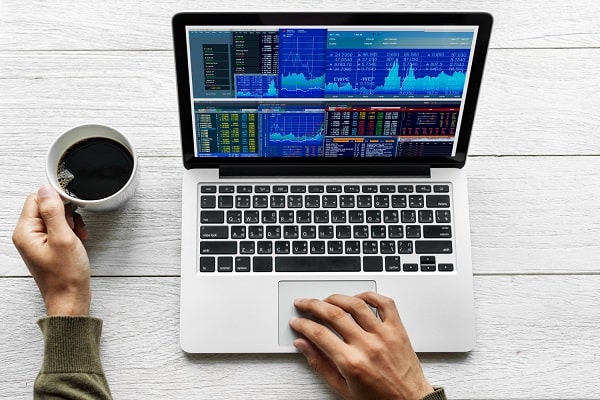
Pros and cons
Pros
This approach can assess both the present value and the expected future value of the company, especially for businesses with potential for future growth, startups or businesses that do not have many fixed assets such as technology companies.
Cons
- Quite difficult to access, which requires the valuator to acquire sound knowledge and experience in handling complex financial models.
- Require many input variables and subjective assumptions of the analyst. However, with a new project or an upcoming project, it is difficult to identify variables and make reasonable assumptions. This can lead to errors or results that are dictated by the biased aspiration of the valuator.
- The probability of error is relatively high. It can be seen that the final estimated value accounts for 70% of the model, but the calculation of the value is relatively sketchy. Moreover, future events always have many unpredictable risks.
Market value valuation method (the Market Approach)
This is an approach to determine the value of a business in terms of market realities based on the P/E ratio.
Overview
- Definition
The price-to-earnings ratio (P/E ratio) is the ratio for valuing a company that measures its current share price relative to its earnings per share. The essence of this method is to compare the company’s P/E ratio with its competitors in the market to find the most suitable correlation value for the business.
P/E = Stock Price Per Share/Earnings Per Share
or
P/E = Market Capitalization/Total Net Earnings
- When to apply?
When there is data on rival enterprises in the market listed on the stock exchange or UPCom for comparison.
Pros and cons
Pros
- Simple and accessible
Financial indicators of enterprises listed on the stock exchange or traded on UPCom are standardized. Therefore, it is relatively easy to get data and calculate.
- Based on market price
This is the valuation approach from a market perspective on the basis of comparison with direct competitors in their field, so the value of the business can reflect the actual market situation at the calculation timing.
Cons
- Business value is accurately reflected only at the calculation timing
Since the comparison is based on actual market prices, valuators tend to overlook the growth potential as well as the potential risks of the business. As a result, this method may not fully reflect the true value of a business, especially those with potentially large future profits.
- Error due to inaccurate market price reflection
Market prices are determined by supply and demand. In some cases, due to psychological impact from investors, the market value may fluctuate very high or low compared to the actual value of the business. If prices are used at these times for valuation, the result may not be accurate.
- Limited to listed businesses
As described above, this approach uses data of rival businesses that have been listed as a basis for comparison and pricing. It will be difficult for startups or unlisted companies to apply.
Notes in the process of business valuation
Determining business value is the activity that requires a lot of knowledge, experience as well as vision. Here are some important notes when conducting a valuation:
- Choose an appropriate valuator
Accurate valuation requires an expert in numbers and possessing a sound understanding of the industry and the market in which the company operates. Therefore, there should be careful consideration and specific criteria to choose the right valuator.
- Properly and sufficiently assess the growth potential of the business
Traditional valuation methods often refer to current numbers like sales, profits, or EBITDA (Earnings Before Interest, Taxes, Depreciation, and Amortization). However, a thorough valuation also needs the prediction of the picture of the business for at least the incoming 5 years to see the full potential of development as well as possible risks. Market is always moving, so the assessment should not just stop at a static state.
- Combine qualitative and quantitative methods
The terminology “valuation” makes most people think of quantitative methods with a lot of metrics to deal with. This is true but not enough.
Qualitative factors such as human and company culture may not be quantified by data, but significantly contribute to the development of the business. That is also the reason why investment funds, especially venture capital funds, consider humans as one among the key factors to consider investing.
The foregoing is a brief overview of common business valuation methods. In fact, determining the value of a company is rather complicated and requires time to learn and evaluate. Valuation is not simply calculating the numbers, it is an art that requires an investment of knowledge and effort!
Cơn sốt Game NFT và “miếng bánh” tỷ đô
Khi game Axie Infinity, một trong những dự án game blockchain nổi bật do người Việt sáng lập, với đồng tiền mã hóa AXS của dự án này có thời điểm giá trị vốn hóa lên tới hơn 8 tỷ USD và trở thành game NFT đắt giá nhất mọi thời đại, thì một trào lưu game thế hệ mới – game dựa trên nền tảng công nghệ blockchain – trong “miếng bánh” tỷ đô dường như bắt đầu định hình và sôi động tại Việt Nam.

Game NFT đang bùng nổ như một xu hướng mới và tạo thành một làn sóng trên thị trường game hiện nay. Game được xây dựng và phát triển trên nền tảng công nghệ blockchain có token hoá tài sản trong game, cho phép người chơi thu thập các vật phẩm dưới dạng non-fungible token (NFT). Ngoài tính chất giải trí, loại game này còn cho phép người chơi kiếm tiền (play-to-earn), được chuyển đổi các vật phẩm trong game thành tài sản có thể giao dịch bất cứ lúc nào.
Làn sóng Game NFT tại Việt Nam
Theo báo cáo của trang Economic Time, vốn hóa thị trường của NFT trên toàn cầu là 11,72 tỷ USD. Theo nguồn DappRadar, tổng giá trị giao dịch NFT trên các nền tảng blockchain tăng mạnh, đạt 1,23 tỷ USD và 1,24 tỷ USD vào quý 1 và 2 năm 2021. Theo messati.io, tổng giá trị vốn hoá của NFT game đạt 7,63 tỷ USD năm 2021, tăng đột biến 2.300% so với 2017.
Thị trường game NFT Việt Nam bắt đầu sôi động từ tháng 4/2021, được dự đoán đang bùng nổ và sẽ tiếp tục phát triển. Nhiều game NFT ra đời một thời gian đã có sự thay đổi về số lượng (được nhân rộng và gây được sự chú ý từ cộng đồng) và chất lượng (nhiều game NFT đã có hình ảnh và đồ họa được cải tiến công phu).

Một trong những game NFT do người Việt sáng lập nổi tiếng nhất hiện nay, trên phạm vi toàn cầu, là game Axie Infinity. Axie Infinity được phát triển bởi Sky Mavis, được thành lập vào năm 2018 bởi ba người Việt và hai người nước ngoài. Công ty khởi nghiệp game blockchain Việt này đã huy động được 7,5 triệu USD ở vòng gọi vốn Series A từ tỷ phú nổi tiếng người Mỹ Mark Cuban và một số nhà đầu tư hồi tháng 5/2021. Đặc biệt, sau vòng gọi vốn thành công trên, cùng “sức nóng” của Axie Infinity, đầu tháng 10 mới đây, công ty của game NFT này tiếp tục huy động được 152 triệu USD trong vòng gọi vốn series B.
Cùng thời điểm này, đầu tháng 10, đồng tiền số AXS của Axie Infinity lập đỉnh mới với giá trị vốn hóa đạt hơn 8 tỷ USD. Trước đó, đầu tháng 7, AXS lần đầu cán mốc 1 tỷ USD và cũng là đồng tiền số (AXS) đầu tiên do người Việt phát triển đạt cột mốc này.
Ngoài Axie Infinity, trong nước, một tựa game NFT khác là game HeroVerse (Vũ trụ anh hùng) – một dự án Game NFT Việt Nam (tháng 9) cũng gọi vốn thành công 1,7 triệu USD từ các quỹ đầu tư hàng đầu trong lĩnh vực Blockchain và NFT như DaoMaker; x21; AU21 Capital; Raptor Capital, IceTea Labs…
“Làn sóng” phát triển game NFT tại Việt Nam có thể do tác động của dịch Covid-19 khiến xu hướng làm việc tại nhà tăng mạnh, từ đó việc chơi game, tìm kiếm mô hình game mới đã kéo theo sự tăng trưởng đột phá của dòng game NFT. Với lợi thế về lối chơi mới, tạo điều kiện để người chơi thu lợi nhuận cao, game NFT trở thành lựa chọn hàng đầu của các game thủ hiện nay.

Cơ hội để game Việt ra toàn cầu
Việt Nam đang hội tụ nhiều thuận lợi để phát triển ngành công nghiệp game, đặc biệt là game thế hệ mới NFT. Theo thống kê của App Annie, trong 68 triệu người dùng di động tại Việt Nam, có khoảng 57% chơi game. Thời gian trung bình hàng ngày cho game của họ lên tới 3,9 tiếng, nhiều hơn 10% so với người Mỹ. Việt Nam đứng thứ hai tại Đông Nam Á về thị phần tải game trên các ứng dụng mobile, 22% sau Indonesia (38%). Số lượt tải game tại thị trường game Việt Nam tăng trưởng 10%, chi tiêu của người dùng trong game tăng 50% trong năm 2020.
Năm 2021 thế giới có gần 3 tỷ người chơi game, tăng 5,3% so với năm 2020. Doanh số thị trường game ước tính chạm ngưỡng 175,8 tỷ USD năm 2021 và 218,7 tỷ USD năm 2024 (thống kê của Newszoo). Và Việt Nam được đánh giá là một trong những nước có tiềm năng về phát triển game. Trong Top 10 nhà xuất bản game mobile, giữa các quốc gia Đông Nam Á, Australia và New Zealand, Việt Nam có 5 nhà phát hành game lọt vào danh sách, gồm Amanotes, OneSoft, Gamejam, VNG, Arrasol.
Lấy ví dụ từ trường hợp Axie Infinity, bà Lyn Hoàng, Giám đốc quốc gia Binance Việt Nam, cho rằng ngành công nghiệp game là ngành mới nhất bị “phá vỡ” bởi công nghệ blockchain, khi mà game kết hợp blockchain này của Việt Nam (Axie Infinity) đã trở thành một hiện tượng công nghệ toàn cầu, thu hút hàng trăm nghìn game thủ từ khắp nơi trên thế giới. “Blockchain, đặc biệt là NFT, đã mở ra các mô hình kinh doanh mới và nguồn doanh thu mới cho ngành công nghiệp game. Các công ty game Việt Nam nên tận dụng để vươn ra toàn cầu”, bà Lyn Hoàng nói.
Theo các chuyên gia trong ngành, tiềm năng của các dự án Việt trong lĩnh vực game NFT là rất lớn. Thậm chí, do đây là lĩnh vực mới nên không không có sự phân biệt quá nhiều giữa các nước lớn về công nghệ như Mỹ, Trung Quốc… Bởi vậy, nếu có ý tưởng và đội ngũ phù hợp, dự án game NFT của các start-up có thể nhận đầu tư và cố vấn từ chuyên gia blockchain, và hoàn toàn có cơ hội để trở thành những dự án tỷ USD.
Giới trong ngành cho rằng thuận lợi của Việt Nam là có lực lượng kỹ sư dồi dào, với kỹ thuật tốt và chuyên cần, tuy nhiên phần lớn đội ngũ này lại yếu về tầm nhìn, năng lực quản lý cũng như khả năng kết nối các nguồn lực quốc tế. Do vậy, theo các chuyên gia, nếu được bổ sung các yếu tố này, kết hợp với việc được đầu tư tài chính, sự hỗ trợ của cộng đồng, các dự án game NFT sẽ được đẩy lên tầm cao hơn và phát triển bền vững.
Việt Nam có thuận lợi trong việc phát triển thị trường NFT game như đội ngũ lập trình, kỹ sư dồi dào, chuyên cần và kỹ thuật tốt, nhưng theo ông, trong nước hiện vẫn chưa có những game NFT bom tấn (đầu tư từ 10 triệu USD trở nên). Cộng đồng quốc tế thường đánh giá tốt những dự án game NFT của Việt Nam như Axie Infinity, HeroVerse vì nhiều studio game Việt Nam có thể làm nên chất lượng thế giới. Tuy vậy, cộng đồng Việt Nam thì không chuộng dự án game NFT trong nước.
Ngoài ra, quy mô thị trường NFT game vẫn nhỏ so với thị trường game truyền thống. Hiện nay người chơi NFT game chủ yếu xuất phát từ các nước châu Á như Philippines, Indonesia, Thái Lan, Việt Nam, Ấn Độ… Game truyền thống có thời gian phát triển lâu hơn nên phủ rộng hơn trên thế giới.
Lợi thế và cũng là điểm khác biệt của game NFT là mục đích và quy mô người chơi. Hiện nay mục đích của đa số người chơi game NFT là để kiếm tiền (play-to-earn) và giao dịch tiền mã hóa, còn người chơi game truyền thống với mục đích tìm kiếm niềm vui. Đặc biệt, doanh thu của game NFT chủ yếu dựa trên việc bán token nhiều hơn là việc thu tiền từ người chơi như game truyền thống. Mặt khác, game NFT có thể gọi vốn dễ dàng và nhanh hơn từ nhà đầu tư (bởi đang là xu hướng và tiềm năng nhanh chóng thu lại lợi nhuận), còn đối với game truyền thống, nhà phát hành thường tự bỏ vốn để làm.
Trong tương lai, NFT game ứng dụng công nghệ blockchain tiếp tục cung cấp những cải tiến đáng kể cho người chơi và nhà phát hành, đặc biệt là tính phân quyền, tính minh bạch và khả năng tương tác trong game. Người chơi có thể trở thành người dùng blockchain mới tiềm năng khi các vật phẩm thu được trong trò chơi được chuyển thành NFT. Ngoài thế giới ảo của game, các tài sản ở thế giới thực như bất động sản, tác phẩm nghệ thuật cũng có thể được mã hóa và giao dịch trên blockchain.
Chính vì thế, theo các chuyên gia, dù quy mô thị trường của game NFT vẫn còn khá nhỏ (vì mới bắt đầu) nhưng loại game này được kỳ vọng sẽ mang lại những thay đổi mới, cải tiến mạnh mẽ về cơ sở hạ tầng và giao diện người chơi trong game nói chung. Ngoài những lợi ích mà NFT game mang lại, người chơi cần chú ý tới một số vấn đề. Vì NFT có giá trị nội tại, nguy cơ được sử dụng làm tài sản đầu cơ. Điều này có thể thúc đẩy người chơi mua tài sản trong game với hy vọng bán chúng để thu lợi nhuận trong tương lai thay vì sử dụng tài sản trong hệ sinh thái trò chơi như dự định.
Theo Vneconomy
Tổng quan về các phương pháp định giá doanh nghiệp
Khi nhắc đến hoạt động đầu tư, không thể không nhắc đến khái niệm giá trị doanh nghiệp. Tuy nhiên, để xác định được chính xác giá trị của một công ty là điều không dễ dàng. Bài viết dưới đây sẽ giới thiệu tổng quan về các phương pháp định giá doanh nghiệp.
Phương pháp định giá dựa trên tài sản (cách tiếp cận từ tài sản)
Đây là một trong những phương pháp định giá truyền thống giúp phản ánh thực tế doanh nghiệp tại một thời điểm. Tuy nhiên, cách tiếp cận này còn tồn tại nhiều hạn chế.

Tổng quan về định giá doanh nghiệp theo phương pháp tài sản
- Định nghĩa: Phương pháp định giá doanh nghiệp theo giá trị tài sản cho rằng, giá trị của một doanh nghiệp sẽ bằng giá trị của tất cả các loại tài sản riêng trên bảng cân đối kế toán trừ các khoản nợ phải trả. Giá trị của tài sản được đánh giá bằng hiệu quả sử dụng và khai thác các tài sản đó, giúp tạo ra lợi ích kinh tế trong tương lai.
Giá của vốn chủ sở hữu = Tổng tài sản – Tổng nợ phải trả
- Đối tượng áp dụng: Phương pháp xác định giá trị doanh nghiệp theo tài sản thường được áp dụng cho các doanh nghiệp vừa và nhỏ, với quy mô tài sản hợp lý. Thông thường là các doanh nghiệp sản xuất kinh doanh mà các tài sản như máy móc thiết bị, nhà xưởng, các phương tiện vận tải, các trang thiết bị … có vai trò quan trọng đối với sự phát triển của công ty. Các doanh nghiệp khác như doanh nghiệp thương mại, doanh nghiệp công nghệ, hoặc các công ty kinh doanh về tài chính thường sẽ áp dụng phương pháp phương pháp chiết khấu dòng tiền.
Ưu điểm, nhược điểm của định giá doanh nghiệp theo phương pháp tài sản
Ưu điểm: Phương pháp đơn giản, thực hiện dễ dàng. Thông thường các thông số về tài sản và nợ đã có sẵn trên các báo cáo tài chính. Do đó, việc tính toán sẽ tương đối dễ thực hiện và không đòi hỏi nhiều kỹ năng cũng như nguồn lực phức tạp.

Nhược điểm:
- Phương pháp định giá này xuất phát từ quan điểm rằng Giá trị tài sản của doanh nghiệp được phản ánh ở trên bảng cân đối kế toán tương đương với một số tiền nhất định và có thể sử dụng ngay được. Tuy nhiên, quan điểm này lại không tính đến trường hợp phát sinh các nghĩa vụ thuế, liên quan đến giá trị tài sản của doanh nghiệp. Do đó, giá trị thực sự có thể sử dụng thường sẽ thấp hơn giá trị được xác định trên bảng cân đối.
- Việc định giá doanh nghiệp dựa trên nguồn tài sản hiện có chỉ căn cứ vào cơ sở tính toán giá trị ở trạng thái tĩnh trong một thời điểm. Phương pháp này chưa tính đến khả năng doanh nghiệp có thể kết hợp các tài sản để tạo ra lợi nhuận tiềm năng lớn hơn trong tương lai cũng như các rủi ro phát sinh nếu có.
- Để xác định giá trị thực tế của các tài sản hiện có là điều không hề dễ dàng. Khi nói đến tài sản, doanh nghiệp sẽ cần phải cân nhắc đến các yếu tố như chi phí, thuế phải trả nếu thanh lý tài sản, khả năng có thể thanh lý tài sản trên thị trường, cách xác định giá trị của các tài sản vô hình như uy tín và thương hiệu,… Những yếu tố này thường được quyết định một cách chủ quan theo ý muốn của người định giá dẫn đến khó phản ảnh thực tế giá trị doanh nghiệp.
Định giá theo phương pháp chiết khấu dòng tiền (cách tiếp cận từ thu nhập)
Phương pháp chiết khấu dòng tiền là phương pháp khá hiệu quả và được sử dụng rộng rãi. Tuy nhiên, đây là cách tiếp cận khá phức tạp đòi hỏi nhiều chuyên môn cũng như dữ liệu đầu vào. Dưới đây là thông tin cụ thể:
Tổng quan về phương pháp chiết khấu dòng tiền
- Định nghĩa: Phương pháp chiết khấu dòng tiền định giá doanh nghiệp bằng cách đưa ra những dự đoán về dòng tiền trong tương lai mà công ty có thể tạo ra sau đó chiết khấu về thời điểm hiện tại. Giả định giá trị của doanh nghiệp sẽ tương đương với tổng giá trị hiện tại của dòng tiền mà doanh nghiệp có thể tạo ra trong tương lai. Công thức tính như sau:
DCF = CF1/(1+r)^1+ CF2/(1+r)^2+ …+ CFn/(1+r)^n
Trong đó:
- DCF – Discounted cash flow: Giá trị của công ty hay còn gọi là dòng tiền đã được chiết khấu.
- CF – Cash flow: Dòng tiền mà công ty có thể tạo ra trong các năm tới (năm 1, năm 2,… năm n).
- r – discount rate: Tỷ lệ chiết khấu của dòng tiền.
Đối tượng áp dụng: Phương pháp xác định giá trị doanh nghiệp dựa trên chiết khấu dòng tiền thường được áp dụng đối với các các doanh nghiệp có tình hình tài chính tương đối tốt, có khả năng thanh toán nợ cao, tính thanh khoản cao, nguồn vốn lớn và có khả năng kinh doanh để tạo ra lợi nhuận bù đắp hết các loại chi phí.

Ưu điểm, nhược điểm của phương pháp chiết khấu dòng tiền
Ưu điểm: Giúp đánh giá được cả giá trị trong hiện tại và giá trị tương lai của công ty. Đặc biệt là đối với các doanh nghiệp mà giá trị tiềm năng được tạo ra trong tương lai, các doanh nghiệp mới như startup hoặc các doanh nghiệp không có nhiều tài sản cố định như công ty công nghệ.
Nhược điểm:
- Phương pháp này tương đối khó, đòi hỏi người định giá cần có kiến thức, kinh nghiệm về kinh doanh và xử lý các mô hình tài chính phức tạp.
- Cần nhiều biến đầu vào và các giả định chủ quan của nhà phân tích. Tuy nhiên, trong trường hợp các dự án mới hoặc dự án sắp triển khai, thì việc xác định được các biến đó và đưa ra các giả thiết hợp lý thường rất hạn chế. Điều này có thể dẫn đến sai sót hoặc bị áp đặt bởi mong muốn chủ quan của người định giá.
- Khả năng xảy ra sai số tương đối cao. Có thể thấy giá trị ước tính sau cùng chiếm đến 70% mô hình, tuy nhiên việc tính toán giá trị lại tương đối sơ sài. Hơn nữa, các sự kiện trong tương lai luôn tồn tại rất nhiều rủi ro khó lường. Vì vậy, khó có thể đảm bảo tính chính xác cao đối với phương pháp định giá này.
Định giá theo phương pháp dựa trên tỷ số P/E (cách tiếp cận từ thị trường)
Chắc hẳn các nhà đầu tư chứng khoán rất quen thuộc với khái niệm P/E. Đây chính là cách tiếp cận giúp xác định được giá trị của doanh nghiệp dưới góc độ thực tế thị trường. Dưới đây là thông tin cụ thể:

Tổng quan về phương pháp định giá dựa trên tỷ số P/E
Định nghĩa: Phương pháp P/E (hay giá trị thị trường trên thu nhập) là tỷ số để xác định giá trị của một doanh nghiệp, dựa vào mối tương quan giữa giá trị thị trường của của cổ phiếu với lợi nhuận sau thuế của công ty. Bản chất phương pháp này là so sánh tỷ số P/E của doanh nghiệp với các đối thủ trong ngành trên thị trường để tìm ra giá trị phù hợp nhất.
P/E = Giá một cổ phiếu/ thu nhập trên một cổ phiếu
hoặc
P/E = Tổng giá trị vốn hóa thị trường/ Tổng thu nhập ròng
Đối tượng áp dụng: Để áp dụng phương pháp này cần có cơ sở so sánh (là các doanh nghiệp đối thủ trên thị trường đã niêm yết trên sàn chứng khoán hoặc sàn UPCom).
Ưu điểm, nhược điểm của phương pháp định giá dựa trên tỷ số P/E
Ưu điểm:
- Đơn giản và dễ tiếp cận: Thông thường các doanh nghiệp đã niêm yết trên sàn chứng khoán hoặc giao dịch trên sàn UPCom có số liệu công khai đầy đủ và chuẩn mực về các chỉ số tài chính. Do đó việc lấy số liệu và tính toán tương đối dễ dàng.
- Dựa trên cơ sở giá thị trường: Như thông tin ở trên, đây là phương pháp định giá theo cách tiếp cận từ thị trường, trên cơ sở so sánh với các đối thủ trực tiếp trong ngành. Do đó, giá trị của doanh nghiệp sẽ phản ánh thực tế tình hình thị trường ở thời điểm tính toán.
Nhược điểm:
- Giá trị doanh nghiệp chỉ được phản ánh ở thời điểm hiện tại: Vì việc so sánh dựa vào giá thực tế trên thị trường nên nhà đầu tư đã bỏ qua các yếu tố về tiềm năng tăng trưởng cũng như rủi ro có thể có trong tương tai của doanh nghiệp. Do đó, phương pháp này có thể không phản ánh đầy đủ giá trị thực sự của một doanh nghiệp, đặc biệt là các doanh nghiệp mà tiềm năng lợi nhuận lớn trong tương lai.
- Khả năng sai số do sự phản ánh giá không chính xác của thị trường: Thông thường giá thị trường được quyết định bởi cung và cầu. Trong một số trường hợp do tác động tâm lý nhà đầu tư, việc giá trị thị trường có thể biến động quá cao hoặc quá thấp so với giá trị thực tế của doanh nghiệp. Nếu sử dụng giá ở những thời điểm này, việc định giá sẽ không thực sự chính xác.
- Giới hạn ở các doanh nghiệp đã lên sàn: Như đã trình bày ở trên, phương pháp này sử dụng các doanh nghiệp đối thủ đã lên sàn để làm cơ sở so sánh và định giá. Trong trường hợp các công ty khởi nghiệp hoặc vì một số lý do chưa thể lên sàn thì rất khó để áp dụng.
Những lưu ý trong quá trình định giá doanh nghiệp
Xác định giá trị doanh nghiệp là hoạt động đòi hỏi nhiều kiến thức, kinh nghiệm cũng như tầm nhìn. Sau đây là một số lưu ý quan trọng khi tiến hành định giá:
- Hãy chọn đúng người cố vấn: Thông thường khi nhắc đến định giá, chúng ta sẽ nghĩ những cái tên như công ty định giá, ngân hàng đầu tư. Tuy nhiên, thực tế việc lựa chọn cố vấn quan trọng hơn thế. Để định giá một cách chính xác nhất không chỉ cần một chuyên gia giỏi tính toán những con số, mà còn cần một đối tác thực sự am hiểu sâu sắc về ngành kinh doanh và thị trường mà công ty đang hoạt động. Do đó, nên có sự cân nhắc kỹ lưỡng và đưa ra những tiêu chí cụ thể để chọn cố vấn phù hợp.

- Nhìn đúng và đủ về tiềm năng tăng trưởng của doanh nghiệp: Các phương pháp định giá truyền thống thường sẽ nhìn vào những con số hiện tại như doanh thu, lợi nhuận hay EBITDA (doanh thu trước lãi vay, thuế, khấu hao và khấu trừ dần). Tuy nhiên, một định giá đầy đủ nên có cả dự đoán về bức tranh của doanh nghiệp trong ít nhất 5 năm tới, để nhìn thấy được hết khả năng phát triển cũng như rủi ro có thể gặp phải. Thị trường luôn luôn vận động và phát triển, do đó việc đánh giá cũng không nên chỉ dừng ở trạng thái tĩnh.
- Hãy cân nhắc việc kết hợp phương pháp định tính và định lượng: Thuật ngữ định giá khiến hầu hết mọi người nghĩ đến các phương pháp định lượng với rất nhiều số liệu phía sau. Điều này đúng nhưng chưa đủ. Những yếu tố như con người, văn hóa công ty có thể không định lượng được bằng số liệu nhưng lại đóng góp rất lớn vào sự phát triển của doanh nghiệp. Đó cũng là lý do mà các quỹ đầu tư, đặc biệt là quỹ đầu tư mạo hiểm sẽ coi con người là một trong những yếu tố cốt lõi cân nhắc để quyết định đầu tư.
Trên đây là tổng quan thông tin về phương pháp định giá doanh nghiệp. Trong thực tế việc xác định giá trị của một công ty thường diễn ra khá phức tạp và đòi hỏi cần có thời gian để tìm hiểu và đánh giá. Định giá không đơn giản chỉ là tính toán ra những con số, định giá là một nghệ thuật cần có sự đầu tư!
Business Valuation for Investors: Definition and Methods. What business valuations are and how to do them
In recent years, business valuation has been attracting the interest of many investors due to the warming of the stock market. However, not everyone fully understands the purpose or process of determining the value of a business. The following article of Vitex Capital is an overview of the definition, why and how of business valuations.
Overview of business valuation
What is Business Valuation?
Business valuation can be described as the process or result of determining the economic value of a company. Valuation is different from pricing. Valuation is intrinsic; it’s based on the actual performance of the business. Pricing results from supply and demand; it incorporates market influences such as overall direction of prices, other investors, and new information such as rumors and news.
Why You Would Need To Do a Business Valuation
- Take as a basis to build business strategies
Every year, businesses will determine their long-term, medium-term and short-term development strategies to address problems in different time frames. Business leaders certainly need to have a sound understanding about the value and position so that they can bring out the most appropriate strategies for development. This is the primary purpose of business valuation.

- Execute a sale or purchase of a business
To be able to reach the final decision about the sale, purchase, or merger of a business, calculating the accurate value of the business is fundamental to negotiations. Valuations are used to benchmark buy-ins and buy-outs for partners and shareholders. By determining the value, the seller will propose a number that is attractive enough to potential investors, but not too detrimental to themselves. The buyer also have to carefully consider the intrinsic value and potential of the company before coming to the official decision.
- Borrow capital or call for investment
In the case of not having enough capital, companies often resort to debt instruments or call for investments as financial leverage. However, in order to succeed in taking out a loan or calling for investment (especially official channels such as banks), proving the ability to repay the debt is a prerequisite. Lenders and investors need to give careful consideration to the real value and growth potential before arriving at the conclusion whether to lend or invest in the company.
- Valuate corporate shares
In the case the business owner wants to attract new and existing shareholders, or issue shares to the public, business valuation is of crucial importance. Through such activities, business owners as well as investors can determine the value of corporate shares, so that being able to reach the right decision related to buying and selling shares.

- Develop an exit strategy
Investors when pouring money into a business will often determine their exit strategy, or business owners will have plans to sell the company in the long term. Through valuations, investors or business owners will have a development strategy to quickly increase profits and value of the company to facilitate the exit plan.
- Resolve legal-related issues
Legal events like dispute, divorce, inheritance, etc. involved in the split or decentralization of the company will require business valuation. For these events, lawyers and relevant parties will conduct business valuation and handle in accordance with the law.
What Business Valuation Means to related sides
- For competent authorities
Valuation of businesses helps to provide the overview of the market situation, thereby devising appropriate strategies to support the management and development of the enterprise ecosystem.
- For Businesses
Determining the business value helps executives form a basis to consider and make strategic decisions to navigate their developmental pathway.
- For business-related partners
Business valuation helps partners such as suppliers, customers, shareholders, investors, etc. have sufficient ground to make business and investment agreements in the most effective way.
Macro and micro factors that affect the value of any businesses
There is a myriad of factors that have a strong influence on how successful the business is. Therefore, in order to accurately calculate the business valuation, it appears necessary to identify factors that may have a considerable impact on the performance of a company, including internal and external factors as follows:
Intrinsic factors
- Asset status
Assets are tangible factors that support the production process and determine the quality of products and services of an enterprise. In addition, assets are also resources that businesses can sell for particular purposes. Therefore, this is regarded as a decisive aspect to show the capacity and potential of the business.
- Location
The meaning of “location” includes both area and topography of the business. These aforementioned factors will create favorable conditions for attracting customers and transporting goods. Besides, location also dramatically influences the operating costs of the business. The most optimal location will differ considerably in the business’s field. Accordingly, the determination of location will exercise such an enormous influence on the determination of business value.

- Reputation
Reputation or brand is an intangible element of tremendous value to businesses. Building a good image with customers and partners will significantly contribute to creating a huge potential revenue source. Today, a brand is something that can be transacted with great deal. For this reason, the business valuation process really needs to take this factor into consideration.
- Technical and technological competence
This factor can be said to be of paramount importance, especially for businesses that provide products and services requiring high level of technology. This capacity is shown through factors such as technical level of workers, modern equipment and machinery, intellectual property rights, etc. In the context of a competitive and rapidly changing market, possessing high-tech capabilities help businesses adapt quickly and compete effectively.
- Human capacity
A business being able to stably develop incredibly depends on human factors, especially the group of key executives. Possessing good human capabilities help businesses boost the potential value of the business.
Extrinsic factors
- Macro environment
Factors such as economy, politics, culture – society, science – technology may either create favorable conditions or hinder the process and development potential of businesses. In certain circumstances, the fluctuations of these macro factors can indirectly cause the business to go bankrupt.
- Specific environment
Specific environment refers to industry factors, which have a direct impact and which the enterprise can control to some extent. Specific factors include relationships with customers, suppliers, competitors, government departments & agencies, etc.
Business valuation method
Valuations are usually carried out by a team of experts and by a standard process. Here are the basic steps of a business valuation procedure:
Step 1: Outline a plan and prepare the necessary conditions
The more accurate the business valuation is, the more effective the subsequent decisions will be and vice versa. Hence, relevant parties need to prepare carefully for the valuation activity. To make an effective plan, businesses need to answer the following questions:
- What is the purpose of valuation?
- What are the criteria to be met when conducting a valuation?
- What information is needed for the valuation?
Step 2: Collect and synthesize information on financial statements
The value of any businesses is the present value of expected future profits. To identify these factors, business data in the past is such a valuable source of information.
In addition, appraisers need the balance sheet and income statement of the business for at least the last 5 years to make accurate analysis and predictions.
Furthermore, businesses also need to pay attention to past reporting adjustments (eg: revenue adjustments for tax avoidance/tax planning). The above said adjustments may help businesses reduce taxes in the past, but they cannot reflect the full performance of the business, so it will be detrimental to the valuation.

Step 3: Choose an appropriate business valuation method
There are many different ways to determine business value, and the choice of method will depend on the valuation criteria and capabilities of each company. Some of the common business valuation methods are as follows:
- Net asset value, or book value method
- Discounted cash flow method
- Market value method (using price-to-earnings ratio, known as P/E ratio)
Step 4: Make conclusions and evaluate the business
This is the most important step in the business valuation process. After measuring the value and coming to specific results, we will aggregate the results into a data table for comparison. It is inevitable that there will be a difference in value among methods, but the art of valuation is the understanding of the criteria and prioritizing to arrive at the final value.
Valuing a business is an activity that requires a lot of skills, experience as well as business thinking. We hope that this article will help readers gain useful information, as well as understand the method of determining business value.

